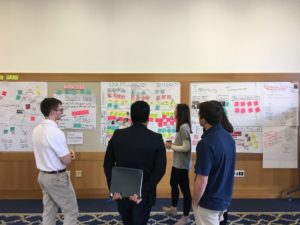Gallery day provided a great platform for us to take a step back and discuss at the big takeaways of our ethnographic research. Peter provided valuable perspective and challenging questions as we discussed our findings with him. Below are the major takeaways and gaps in our research that we want to focus on moving forward.
Takeaways
- The importance of connecting homeless people to substance abuse and mental health services
A common theme among the homeless was a struggle with mental health and substance abuse problems. The cause and effect is not always unidirectional; sometimes being homeless causes someone to take up drinking, and sometimes drinking leads someone into homelessness. We need to think more about out who will pay for these services – the state, charities, the city? And even if they were accessible, would our population of homeless people be willing to use them?
2. Cultural differences that can become a barrier for exiting homelessness.
Many homeless grew up in poverty and this reflects in their attitudes and behavior. However, employers have a bias towards people who understand the middle class cultural script. This disconnect can be part of the problem of homeless being unable to get and hold jobs.
3. Idleness during day could be window of opportunity
Most of the homeless have nothing to do in between meals – the soup kitchens close down, and the shelter does not open until after dinner. The good news is that time does not need to be a constraint for homeless people. Maybe we can use this open time in their day to get them to activities/services that will benefit their health and/or help them exit homelessness.
Remaining Gaps in Research
- Visiting Center for the Homeless
I think it would be valuable for us to fully understand the services that CFH offers. They are known for having a great program to get people back on their feet, and it’d be great to see what they do firsthand. I also think it would be helpful to talk with some of the homeless that live there and ask about their journey to the shelter. I’d also like to better understand some of the barriers that may keep our population out of the shelter. Finally, I’m interested in where their funding comes from and how they choose to allocate it.
2. Exploring funding options
Who would pay for additional programming for the homeless? The city, state government, churches, charities? I think understanding budget constraints may help provide more guidance for our ideation & potential solutions. Moving forward, I think we should try to talk with the current soup kitchens & CFH to understand where their money comes from, and we should also talk with people involved on the city council.
 .
.